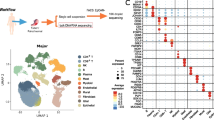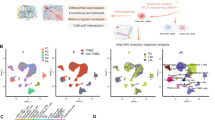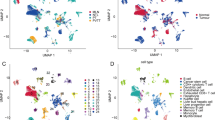Abstract
Triple-negative breast cancer (TNBC) is characterized by a more aggressive clinical course with extensive inter- and intra-tumour heterogeneity. Combination of single-cell and bulk tissue transcriptome profiling allows the characterization of tumour heterogeneity and identifies the association of the immune landscape with clinical outcomes. We identified inter- and intra-tumour heterogeneity at a single-cell resolution. Tumour cells shared a high correlation amongst stemness, angiogenesis, and EMT in TNBC. A subset of cells with concurrent high EMT, stemness and angiogenesis was identified at the single-cell level. Amongst tumour-infiltrating immune cells, M2-like tumour-associated macrophages (TAMs) made up the majority of macrophages and displayed immunosuppressive characteristics. CIBERSORT was applied to estimate the abundance of M2-like TAM in bulk tissue transcriptome file from The Cancer Genome Atlas (TCGA). M2-like TAMs were associated with unfavourable prognosis in TNBC patients. A TAM-related gene signature serves as a promising marker for predicting prognosis and response to immunotherapy. Two commonly used machine learning methods, random forest and SVM, were applied to find the genes that were mostly associated with M2-like TAM densities in the gene signature. A neural network-based deep learning framework based on the TAM-related gene signature exhibits high accuracy in predicting the immunotherapy response.








Similar content being viewed by others
Availability of data and material
All the data used in this study can be found in TCGA and GEO database. All presented data in this study are available from the corresponding author upon reasonable request.
References
Foulkes WD, Smith IE, Reis-Filho JS (2010) Triple-negative breast cancer. N Engl J Med 363(20):1938–1948
Chung W, Eum HH, Lee H-O, Lee K-M, Lee H-B, Kim K-T et al (2017) Single-cell RNA-seq enables comprehensive tumour and immune cell profiling in primary breast cancer. Nat Commun 8(1):1–12
Shah SP, Roth A, Goya R, Oloumi A, Ha G, Zhao Y et al (2012) The clonal and mutational evolution spectrum of primary triple-negative breast cancers. Nature 486(7403):395–399
Karaayvaz M, Cristea S, Gillespie SM, Patel AP, Mylvaganam R, Luo CC et al (2018) Unravelling subclonal heterogeneity and aggressive disease states in TNBC through single-cell RNA-seq. Nat Commun 9(1):1–10
Liedtke C, Mazouni C, Hess KR, André F, Tordai A, Mejia JA et al (2008) Response to neoadjuvant therapy and long-term survival in patients with triple-negative breast cancer. J Clin Oncol 26(8):1275–1281
Hoadley KA, Siegel MB, Kanchi KL, Miller CA, Ding L, Zhao W et al (2016) Tumor evolution in two patients with basal-like breast cancer: a retrospective genomics study of multiple metastases. PLoS Med 13(12):e1002174
Loi S, Sirtaine N, Piette F, Salgado R, Viale G, Van Eenoo F et al (2013) Prognostic and predictive value of tumor-infiltrating lymphocytes in a phase III randomized adjuvant breast cancer trial in node-positive breast cancer comparing the addition of docetaxel to doxorubicin with doxorubicin-based chemotherapy: BIG 02-98. J Clin Oncol 31(7):860–867
Keren L, Bosse M, Marquez D, Angoshtari R, Jain S, Varma S et al (2018) A structured tumor-immune microenvironment in triple negative breast cancer revealed by multiplexed ion beam imaging. Cell. 174(6):1373–87.e19
Brown SD, Warren RL, Gibb EA, Martin SD, Spinelli JJ, Nelson BH et al (2014) Neo-antigens predicted by tumor genome meta-analysis correlate with increased patient survival. Genome Res 24(5):743–750
Bao X, Shi R, Zhang K, Xin S, Li X, Zhao Y et al (2019) Immune landscape of invasive ductal carcinoma tumor microenvironment identifies a prognostic and immunotherapeutically relevant gene signature. Front Oncol 9:903
Bao X, Anastasov N, Wang Y, Rosemann M (2019) A novel epigenetic signature for overall survival prediction in patients with breast cancer. J Transl Med 17(1):380
Leek JT, Johnson WE, Parker HS, Jaffe AE, Storey JD (2012) The sva package for removing batch effects and other unwanted variation in high-throughput experiments. Bioinformatics 28(6):882–883
Butler A, Hoffman P, Smibert P, Papalexi E, Satija R (2018) Integrating single-cell transcriptomic data across different conditions, technologies, and species. Nat Biotechnol 36(5):411–420
Hänzelmann S, Castelo R, Guinney J (2013) GSVA: gene set variation analysis for microarray and RNA-seq data. BMC Bioinform 14(1):7
Chen B, Khodadoust MS, Liu CL, Newman AM, Alizadeh AA (2018) Profiling tumor infiltrating immune cells with CIBERSORT. Springer, Cancer Syst Biol, pp 243–259
Langfelder P, Horvath S (2008) WGCNA: an R package for weighted correlation network analysis. BMC Bioinform 9(1):559
Therneau TM, Grambsch PM (2000) The Cox model. In: Modeling survival data: extending the Cox model. Statistics for Biology and Health. Springer, New York, NY, pp 39–77
Wilkerson MD, Hayes DN (2010) ConsensusClusterPlus: a class discovery tool with confidence assessments and item tracking. Bioinformatics 26(12):1572–1573
Ritchie ME, Phipson B, Wu DI, Hu Y, Law CW, Shi W, Smyth GK (2015) limma powers differential expression analyses for RNA-sequencing and microarray studies. Nucleic Acids Res 43(7):e47–e47
Wright MN, Ziegler A (2015) Ranger: a fast implementation of random forests for high dimensional data in C ++ and R. arXiv preprint arXiv:150804409
Liaw A, Wiener M (2002) Classification and regression by randomForest. R News. 2(3):18–22
Dimitriadou E, Hornik K, Leisch F, Meyer D, Weingessel A (2008) Misc functions of the Department of Statistics (e1071), TU Wien. R package, vol 1, pp 5–24. https://www.researchgate.net/profile/Friedrich_Leisch/publication/221678005_E1071_Misc_Functions_of_the_Department_of_Statistics_E1071_TU_Wien/links/547305880cf24bc8ea19ad1d/E1071-Misc-Functions-of-the-Department-of-Statistics-E1071-TU-Wien.pdf
Paszke A, Gross S, Chintala S, Chanan G, Yang E, DeVito Z, et al (2017) Automatic differentiation in pytorch
Tsai CH, Chiu JH, Yang CW, Wang JY, Tsai YF, Tseng LM et al (2015) Molecular characteristics of recurrent triple-negative breast cancer. Mol Med Rep 12(5):7326–7334
Linderholm B, Hellborg H, Johansson U, Elmberger G, Skoog L, Lehtiö J et al (2009) Significantly higher levels of vascular endothelial growth factor (VEGF) and shorter survival times for patients with primary operable triple-negative breast cancer. Ann Oncol 20(10):1639–1646
Bulfoni M, Gerratana L, Del Ben F, Marzinotto S, Sorrentino M, Turetta M et al (2016) In patients with metastatic breast cancer the identification of circulating tumor cells in epithelial-to-mesenchymal transition is associated with a poor prognosis. Breast Cancer Res 18(1):30
Hanahan D, Weinberg RA (2011) Hallmarks of cancer: the next generation. Cell. 144(5):646–674
Teng MW, Ngiow SF, Ribas A, Smyth MJ (2015) Classifying cancers based on T-cell infiltration and PD-L1. Cancer Res 75(11):2139–2145
Su S, Liu Q, Chen J, Chen J, Chen F, He C et al (2014) A positive feedback loop between mesenchymal-like cancer cells and macrophages is essential to breast cancer metastasis. Cancer Cell 25(5):605–620
Gwak JM, Jang MH, Kim DI, Seo AN, Park SY (2015) Prognostic value of tumor-associated macrophages according to histologic locations and hormone receptor status in breast cancer. PloS One 10(4):e0125728
Shirabe K, Mano Y, Muto J, Matono R, Motomura T, Toshima T et al (2012) Role of tumor-associated macrophages in the progression of hepatocellular carcinoma. Surg Today 42(1):1–7
Yang Z, Xie H, He D, Li L (2016) Infiltrating macrophages increase RCC epithelial mesenchymal transition (EMT) and stem cell-like populations via AKT and mTOR signaling. Oncotarget. 7(28):44478
Ruchat S-M, Houde A-A, Voisin G, St-Pierre J, Perron P, Baillargeon J-P et al (2013) Gestational diabetes mellitus epigenetically affects genes predominantly involved in metabolic diseases. Epigenetics. 8(9):935–943
Coelho D, Kim JC, Miousse IR, Fung S, du Moulin M, Buers I et al (2012) Mutations in ABCD4 cause a new inborn error of vitamin B 12 metabolism. Nat Genet 44(10):1152–1155
Donovan A, Lima CA, Pinkus JL, Pinkus GS, Zon LI, Robine S et al (2005) The iron exporter ferroportin/Slc40a1 is essential for iron homeostasis. Cell Metab 1(3):191–200
Goulart AC, Rexrode KM, Cheng S, Rose L, Buring JE, Ridker PM et al (2009) Association of genetic variants with the metabolic syndrome in 20,806 white women: the women’s health genome study. Am Heart J. 158(2):257–62.e1
Noy R, Pollard JW (2014) Tumor-associated macrophages: from mechanisms to therapy. Immunity 41(1):49–61
Tariq M, Zhang J, Liang G, Ding L, He Q, Yang B (2017) Macrophage polarization: anti-cancer strategies to target tumor-associated macrophage in breast cancer. J Cell Biochem 118(9):2484–2501
Strachan DC, Ruffell B, Oei Y, Bissell MJ, Coussens LM, Pryer N et al (2013) CSF1R inhibition delays cervical and mammary tumor growth in murine models by attenuating the turnover of tumor-associated macrophages and enhancing infiltration by CD8 + T cells. Oncoimmunology. 2(12):e26968
Zhu Y, Knolhoff BL, Meyer MA, Nywening TM, West BL, Luo J et al (2014) CSF1/CSF1R blockade reprograms tumor-infiltrating macrophages and improves response to T-cell checkpoint immunotherapy in pancreatic cancer models. Cancer Res 74(18):5057–5069
Seidel JA, Otsuka A, Kabashima K (2018) Anti-PD-1 and anti-CTLA-4 therapies in cancer: mechanisms of action, efficacy, and limitations. Front Oncol 8:86
Acknowledgements
We greatly thank the China Scholarship Council (CSC) for supporting the research and work of Xuanwen Bao (No. 201608210186), Tianyu Zhao (No. 201708120056) and Run Shi (No. 201708320347). We would like to thank Haowen Deng for helpful discussions and suggestions in building the neural network framework.
Funding
This research received no specific grant from any funding agency in the public, commercial, or not-for-profit sectors.
Author information
Authors and Affiliations
Contributions
WJF and Michael Rosemann conceived and designed the experiments. XWB and RS performed the analysis. XWB, MR and YFW wrote the paper. NA, TYZ, Michael Rosemann, WJ.F and YFW reviewed the draft. All authors read and approved the final manuscript.
Corresponding authors
Ethics declarations
Conflict of interest
The authors declare that there are no conflicts of interest.
Ethics approval and consent to participate
This study is based on published or public datasets and does not include new data that require ethical approval and consent.
Informed consent
All authors reviewed and approved the manuscript.
Additional information
Publisher's Note
Springer Nature remains neutral with regard to jurisdictional claims in published maps and institutional affiliations.
Electronic supplementary material
Below is the link to the electronic supplementary material.
Rights and permissions
About this article
Cite this article
Bao, X., Shi, R., Zhao, T. et al. Integrated analysis of single-cell RNA-seq and bulk RNA-seq unravels tumour heterogeneity plus M2-like tumour-associated macrophage infiltration and aggressiveness in TNBC. Cancer Immunol Immunother 70, 189–202 (2021). https://doi.org/10.1007/s00262-020-02669-7
Received:
Accepted:
Published:
Issue Date:
DOI: https://doi.org/10.1007/s00262-020-02669-7




